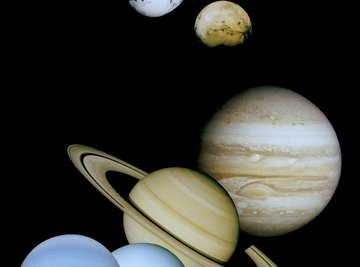
Re-creating the solar system with modeling clay may seem like an easy enough endeavor; many of us learned how to roll clay into a ball long before we were able to speak in sentences. But creating an accurate representation of the solar system is much more challenging when it comes to the issues of realism and scale, both in the size of the planets and the distances between them. Billions of miles must be condensed to mere inches and some allowances must be made even though Pluto’s recent demotion from planet to asteroid makes constructing a model much easier. If you build your model with a 5-inch sun, to be truly accurate, your representation of Mercury would be 0.017 of an inch in diameter and Neptune would be more than 1,770 feet away. Since a true representation is impossible to achieve, focus on making the model as accurately as possible, while additional information can be included next to the depiction of each planet.
- Plastic foam ball
- Foam board
- Black paint
- Wooden dowels
- Toothpicks
Make the sun using yellow clay. The sun is much larger than any other body in our solar system so it is easiest to re-create it using a plastic foam ball available in the floral section of most large craft stores. A ball 8 inches in diameter should be covered with bright yellow clay.
Create Mercury using gray modeling clay. Contrary to popular belief, Mercury appears mostly gray due to having little atmosphere and a rocky surface. If Mercury were in scale with your sun, it would be 0.03 of an inch in diameter and 27 feet from the sun. Since this is not practical, try to focus on the general aspects of each planet. Mercury is the smallest of all the planets and the closest to the sun. Its distance from the sun is relatively small when compared to planets that are farther away.
Make Venus using yellow and white modeling clay rolled together. Venus has an atmosphere of predominately sulfuric acid clouds that appear a soft yellow. Venus is about three times larger than Mercury and orbits relatively close to it.
Use blue and green modeling clay to make Earth. Most of Earth is water, causing the planet to appear largely blue; you can add spots of white to re-create the appearance of clouds. Earth is close in size to Venus and orbits very close to it.
Form Mars with red and orange modeling clay. Mars is a little more than half the size of Earth and, while it orbits relatively close to Earth and the sun, it is farther from us than Venus.
Use orange and white modeling clay in horizontal bands to create Jupiter. Jupiter is the largest planet in our solar system and is more than 10 times the diameter of Earth. Jupiter orbits close to Mars.
Make Saturn using pale yellow modeling clay. Saturn is another large planet more than eight times larger than Earth and is famous for its rings. To create the rings of Saturn, roll some yellow modeling clay flat and carefully cut it into a circle with a hole in the center large enough to fit your planet. Stick several toothpicks into your Saturn in a circle around the center of your planet and lay your ring on top. Saturn orbits fairly close to Jupiter.
Use light blue modeling clay to create Uranus. Uranus and Neptune are both much larger than the inner planets, but not nearly as large as the giants Jupiter and Saturn. Uranus is roughly 3 ½ times the diameter of Earth. The orbit of Uranus is much farther from the sun than any of the other planets you have made so far. It is more than two times the distance from the sun as its neighbor Saturn.
Create Neptune from light blue modeling clay such as you used for Uranus. Uranus and Neptune are similar in size and Neptune also orbits far from the sun. The distance between Uranus and Neptune is slightly larger than the difference between Saturn and the sun.
Paint a piece of foam board black to represent space. Using toothpicks or wooden dowels, attach your planets to the foam board by inserting one end into the base of the planet and the other into the foam board and gluing both into place with a hot glue gun.
Things You'll Need
References
About the Author
Based in Fort Lauderdale, Kay Trillos began writing professionally in 2009. She has written for numerous websites and private customers. Before beginning her writing career Trillos worked in corporate America for five years. She has a degree in history from the University of Florida.
Photo Credits
Jupiterimages/Photos.com/Getty Images
